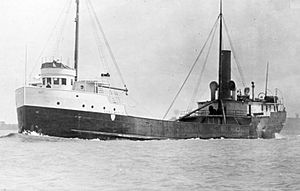SS Benjamin Noble facts for kids

The Benjamin Noble prior to her sinking
|
|
Quick facts for kids History |
|
|---|---|
| Name | Benjamin Noble |
| Operator | Capitol Transportation Company |
| Builder | Detroit Shipbuilding Company, Wyandotte, Michigan |
| Launched | April 28, 1909 |
| In service | 1909 |
| Out of service | 1914 |
| Homeport | |
| Identification | U.S Registry #206240 |
| Fate | Foundered April 28, 1914 off Knife River, Lake Superior |
| General characteristics | |
| Type | canaller |
| Displacement | 1,481 long tons (1,505 t) |
| Length | 239 ft (73 m) |
| Beam | 40 ft (12 m) |
| Height | 18 ft (5.5 m) |
| Propulsion | Triple expansion steam engine |
|
BENJAMIN NOBLE (Shipwreck)
|
|
| Location | Lake Superior near Knife River |
| Nearest city | Duluth, Minnesota |
| Built | 1909 |
| Architect | Detroit Shipbuilding Company |
| Architectural style | Canaller |
| NRHP reference No. | 07000984 |
| Added to NRHP | 2007 |
The SS Benjamin Noble was a large cargo ship, known as a "lake freighter," that sailed on the Great Lakes. Built in 1909, this ship was 239 feet (about 73 meters) long and 40 feet (about 12 meters) wide. It was first designed to fit through canals, but its owners changed it to carry heavy loads on the open lakes. In April 1914, while carrying a huge amount of railroad tracks, the Benjamin Noble sank in a fierce storm on Lake Superior. Sadly, everyone on board was lost.
For over 90 years, the Benjamin Noble was a lost ship. Then, in the autumn of 2004, its remains were found. The shipwreck was added to the National Register of Historic Places in 2007.
Ship Design and Features
The Benjamin Noble was special because of how it was built. Its back cabins were raised up on a deck called a poop deck. The front cabins were also raised on a forecastle deck. This design made the ship sit quite low in the water. This meant that its main deck, called the spar deck, often got wet from waves.
A historian named Dwight Boyer thought that the ship sank because it was carrying too much weight. Also, its unusual design made it less stable. On its last trip, the ship was very low in the water. It had very little freeboard, which is the distance from the water to the deck. This made it easy for waves to wash over the ship.
The Final Voyage
The Benjamin Noble was heading to Duluth, Minnesota, on April 25, 1914. Captain John Eisenhardt was in charge; this was his first time commanding a ship. Another ship, the lumber steamer Norwalk, was also going to Duluth. The Norwalk was behind the Noble and passed it on April 27.
That night, a very strong spring storm hit Lake Superior. The Noble seemed to be following the Norwalk. Around 3 AM, both ships were near Knife Island. Another ship, the Daniel J. Morrell, saw the lights of one of the ships suddenly disappear. The Norwalk managed to reach Duluth harbor at 4:30 AM on April 28. Later that afternoon, parts of the Noble's hatch covers were found washed up on the beach near Duluth. The next day, more wreckage, including the ship's pilot house, was found.
If the Benjamin Noble had been able to reach the safe harbor of Duluth, it might have been saved. But at a very important moment during the storm, the light on the south pier of the harbor went out. This made it impossible to navigate into the harbor. A worker tried to relight the lamp but was swept into the canal. All 16 to 20 crew members on the Benjamin Noble were lost.
Finding the Shipwreck
In the autumn of 2004, a team of shipwreck explorers found the Benjamin Noble. The team included Jerry Eliason, Kraig Smith, Ken Merryman, and Randy Beebe. They were actually looking for another ship, the Robert Wallace. But their special sonar equipment picked up the shape of a different shipwreck.
Randy Beebe described the moment:
- It was the very last search of the day.
- They were about to stop searching for the season.
- They saw something on their sonar screen.
- They checked it more closely with the sonar.
- They realized they had found a shipwreck.
The team thought they would see the Wallace, but the ship they found was made of steel. They used a camera to look inside the mystery ship's cargo area. They saw that it was filled with railroad tracks. This confirmed that they had found the long-lost Benjamin Noble.
Condition of the Wreck
The Benjamin Noble was badly damaged when it sank. The ship is sitting upright in a deep groove it made when it hit the bottom of the lake. The front part of the ship is covered in mud. The back half of the ship is buried almost up to its main deck. The hull, or body of the ship, is split right in front of the boiler room. The back cabins collapsed because of the force of the water as the ship quickly plunged down. The covers for the cargo holds are gone, showing the railroad tracks inside. The back mast has fallen over, and nearby are the ship's vents and a lifeboat.



